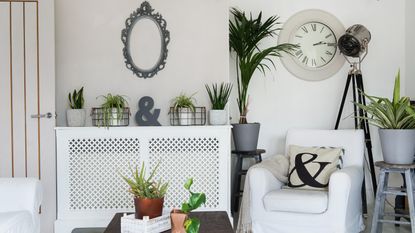Do radiator covers block heat? Experts explain what impact they can have on energy bills
Radiator covers might look good, but could they be adding to your energy bill and making your home colder?


If you are the proud owner of an ugly radiator, you will almost certainly know the benefits of a radiator cover to hide the eyesore. But as we find ourselves amid a cost of living crisis with the energy price cap going up again this month it is important to consider do radiator covers block heat and waste energy before investing in one.
Radiator cover ideas stem from the fact that radiators are not particularly aesthetically pleasing. So covering the appliance with a specially designed piece of furniture that also doubles as a shelf is pretty ingenious, not to mention budget-friendly.
But not if it's preventing the heat from warming up our homes properly. So we asked the heating experts to reveal what impact the best radiator covers can have on your energy bill.

Do radiator covers block heat?
As the January energy price cap took effect, energy prices are set to rise. So we can’t tolerate anything wasting precious heat, even if it is pleasing to the eye.
But luckily for you and your home aesthetic, experts agree that radiator covers don’t block much heat, as long as your radiator cover adheres to a few rules.
‘Radiator covers do not block too much heat as long as they have sufficient gaps for it to escape,’ says Rhiannon Moore at Toolstation.
But Nancy Emery, heating expert at Drench, acknowledges that ‘putting a solid object around your heat source will affect the heat output as it acts as a barrier’. But as long as the cover has sufficient gaps, the heat blockage should be minimal.

Installing a fairly inexpensive radiator reflector can also help with heat properly circulating around the room.
‘To help increase the heat output of a radiator, foil insulation can be installed behind your radiator at a relatively low cost,’ Rhiannon suggests. ‘Well-fitted radiator reflector foil could help to reduce the amount of energy needed to heat your home and could also help to keep the room warmer for longer once the heating is switched off.’

What radiator covers do experts recommend?
‘As a general rule of thumb, it's best to have at least a third of the radiator cover as open holes to allow enough heat to escape,’ Rhiannon says.
Another thing to consider is giving your radiator - and therefore the heat - enough space.
‘It’s a good idea to have enough space between your radiator and your cover so the heat can be distributed more evenly. The gap between the radiator and the cover should be at least 5 centimetres in width, 3 centimetres in height and 3 centimetres in depth to ensure it won’t affect the BTU (British thermal unit) output,’ Nancy recommends.
FAQ
How much do radiator covers reduce efficiency?
Radiator covers block heat only slightly, especially if they have sufficient gaps for the heat to escape through. But how much heat they block also depends on their material.
‘Wooden radiator covers, which are the most common, are the least energy efficient with a study by Liverpool John Moores University revealing that they can reduce heat output by up to 40%,’ Rhiannon reveals.

But we say don’t get rid of your radiator cover just yet.
Get the Ideal Home Newsletter
Sign up to our newsletter for style and decor inspiration, house makeovers, project advice and more.

Sara Hesikova has been Ideal Home’s News Writer since July 2023, bringing the Ideal Home’s readership breaking news stories from the world of home and interiors. Graduating from London College of Fashion with a bachelor’s degree in fashion journalism in 2016, she got her start in niche fashion and lifestyle magazines like Glass and Alvar as a writer and editor before making the leap into interiors. She feels the two are intrinsically connected - if someone puts an effort into what they wear, they most likely also care about what they surround themselves with.
-
 Nigella Lawson swapped out her usual Le Creuset for the celebrity-favourite Always Pan – and we've got some thoughts
Nigella Lawson swapped out her usual Le Creuset for the celebrity-favourite Always Pan – and we've got some thoughtsIs it truly out with the old and in with the new?
By Jullia Joson
-
 Kitchen drawers vs cabinets - which is best for your cooking space?
Kitchen drawers vs cabinets - which is best for your cooking space?Deciding on drawers or cabinets is an essential part of kitchen planning - but why not have both?
By Ellis Cochrane
-
 How to bleed a radiator without a radiator key, according to heating experts
How to bleed a radiator without a radiator key, according to heating expertsYou don’t need a radiator key, but you should exercise caution
By Lauren Bradbury


